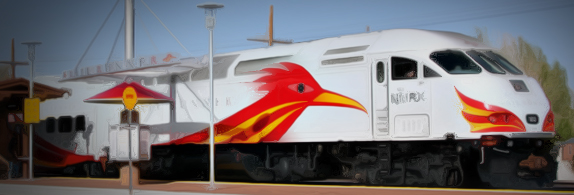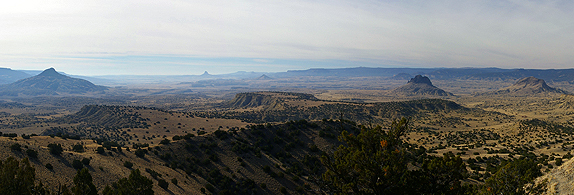He Actually Said It

It was a jaw dropping moment. I actually heard with my own ears a member of the United States House of Representatives, a man with vast power compared to the rest of us, dismiss the whole notion of climate change with a smirk and a smile declaring he’d “Googled It” and agreed with the “31,000 scientists” who thought man-made global warming was all a bunch of hooey.
Republican congressman Steve Pearce said this on Public Television. I saw it on our PBS affiliate. It was during a debate moderated by Sam Donaldson with Democratic challenger Rocky Lara who made the 67-year old Pearce seem like a ventriloquist’s dummy, mouthing the climate-change denying fossil fuel party line. When he tossed her that opening, challenger Lara jumped in and made mincemeat of him, but doing it all with a confident smile.
Who are these “31,000” scientists, I wondered. Searching for an answer took me into back alleys of meaningless statistical warfare, volleys of numbers bouncing off each other like so much oatmeal tossed by a toddler.
On one hand we have the “31,000” and on the other we have the 97% of scientists who form a “consensus” on climate change being caused by human activity.
Who’s right here? Who cares? It isn’t about contested numbers. The history of science is filled with errors believed to be true by many, popular errors that required a heroic rebel and outsider to debunk and bring the world to its senses.
Steve Pearce is not a heroic rebel, though climate change deniers seem to think of themselves that way. He reminds me of someone who would deny the overwhelming consensus among medical scientists that the germ theory of certain diseases is true. To rebel against that view would be a kind of intellectual and moral insanity. And to do so because of a Reaganesque hatred of taxes would be even crazier. But In debating Rocky Lara, Pearce actually said that fear mongering about climate change was really just all about raising taxes. It always comes back to that.
As to the 31, 000 and the 97% fight, let’s try and unravel it. An excellent piece in Scientific American explains that the 97% figure is taken from a survey of 4,014 scientific abstracts on climate change. That overwhelming majority held the assumption that green house gas emissions are causing the current climate change crisis.
The 31,000 climate change denying scientists number comes from something called the Oregon Institute of Science and Medicine (OISM) petition. The signers, 9,029 of whom hold Ph.Ds, held that there’s no evidence that human activities with fossil fuels are causing climate change. An on-line enterprise called the Skeptical Scientist points out that 31,000 scientists sounds like a lot of folks but it’s really only 0.3% of all science graduates in the United States.
More significant in this debate are the findings of the National Aeronautics and Space Administration (NASA) which sides with the 97%ers, and adds that “most of the leading scientific organizations worldwide have issued public statements endorsing this position. “
These organizations include the American Association for the Advancement of Science, the American Chemical Society, the American Geophysical Union, the American Medical Association, the American Meteorological Society, The Geological Society of America, the U.S. National Academy of Sciences, the Intergovernmental Panel on Climate Change, and “nearly 200” other international scientific organizations. They all hold “that climate change has been caused by human action.”
In a world in which reason and evidence prevail, Pearce’s view on climate change would disqualify him from electoral politics. But I was struck most, not by his non-arguments in the debate about global warming with Rocky Lara last week, but with his carefree, jaunty, adolescent dismissal of what in all probability is the most pressing scientific issue of our times, as well as the greatest threat to our national security and to the well-being of all citizens of the world.
He seemed to me to be like a high school debater taking a position to win an argument, a position he knew nothing about but had “Googled it,” found some stuff on it and dreamed up something that might sound convincing.
Is this the kind person we want in the halls of power in Washington, D.C. representing us?
This is not an issue to be dismissed with a rhetorical wave of the hand. The stakes are far, far too high. If the climate change “consensus” that humans are responsible for global warming proves to be wrong in the long run, the costs will be mitigated by the tremendous improvements in air and water quality around the world. Fossil fuels are not just culprits in climate change, as the horribly polluted air in our Four Corners area clearly shows.
But if the climate change deniers are wrong and we fiddle away our last chances to avoid horrific diasporas caused by rising seas swamping coastal cities, major famines caused by drought, the killing off of much of the world’s forests and the increased terrorism and violence that comes with catastrophic change, then we would have allowed mere skepticism and intellectual laziness to deliver a death blow to the world as we know it.
Which position is risker? Which position is irresponsible? Whose motives are trustworthy? Do we trust the deniers who are supported by private interests getting rich on fossil fuels? Or do we trust people who make their findings with no potential for direct financial gain?
Riding the Train and the Buses

I worry what might happen to the Rail Runner Express if Governor Susana Martinez wins re-election and the N.M House of Representatives turns up with a Republican majority. The governor could very well scuttle the Rail Runner and clamp down on any new thinking about transportation systems that cut carbon emissions in the age of global warming. She’s never liked the train because it was a success of her predecessor, Bill Richardson. And her party doesn’t believe in climate change and it prefers automobiles perhaps because they use so much more gasoline than public transit and make Republican money bags richer by the day.
The Rail Runner is a public asset of great worth to many New Mexicans. It is the evolutionary consequence of years of innovative thinking about public transportation that started in l973 during the OPEC oil crisis. Back then a flurry of good ideas about how to move New Mexicans from place to place rolled onto the desks of the state’s journalists. Most of the ideas were ignored of course. Environmentalism wasn’t a hard-bitten editor’s cup of tea. But the world of common sense paid attention.
The barrage of new thinking had a common theme: If gas shortages effectively rationed gasoline for many of us, there were dozens of ways besides our cars to get around town and to do the work we needed to do. And it was not only the fleet of city buses or even the out-of-use school buses that were involved. There were also vans, SUVs, motorcycle fleets, neighborhood taxi entrepreneurs, the high hopes for intercity trains, trolleys and rapid-ride buses, and much more.
The OPEC oil embargo made all this seem plausible to some of us. OPEC, the Organization of Arab Petroleum Exporting Countries, responded to the U.S. supplying arms to Israel during the Yom Kippur War. Arab nations had tried and failed to regain territory lost in the Six Day War of 1967 when Israel captured the Sinai Peninsula, Gaza Strip, West Bank, the Golan Heights, and the Old City of Jerusalem.
The embargo, which also hit Canada, the UK, Japan and the Netherlands, drove up the price of oil from $3 a barrel to almost $12. Along with the stock market crash of 1973-74 and galloping inflation, the OPEC embargo crippled many American cities from October l973 to March l974 when it was lifted. You didn’t want to drive around in Los Angeles if you didn’t have a rented car with a full tank of gas. Lines at the pumps could be blocks long. And tempers were close to the surface.
It was in this economic climate that smart people started to dream up plans for alternative systems of transportation. The objection, of course, was that no major New Mexican city was dense enough for a self-supporting network of public transit. And if such a network could be established, it would always have to be subsidized by government. This was a typical libertarian and right wing objection.
Even now right wing think-tanks object to buses and rail systems because they don’t pay for themselves. But all transportation systems, including automobiles, must use infrastructure paid for by taxpayers. Even privatized public transit has infrastructure subsidies. Both public and private transit systems work.
European and Asian public transit systems are run largely by private, profit-making enterprises. In the United States public transit is operated by municipalities and states. But the same conditions exist for both – public subsidies of infrastructure that no transit system can do without.
As times get harder in New Mexico and as income inequality increases pubic transit will remain ever more popular. And should the climate change crisis require a curtailment of automobile use, cities and states with solid public transit systems will prosper with greater ease than those that do not.
Albuquerque’s rapid transit bus line has been steadily increasing its ridership. Last year, there were almost 13 million passenger boardings. This includes free passage for veterans. And Road Runner ridership to Santa Fe via Belen, Albuquerque and Bernalillo, since 2006 when the line opened, reached a million passengers in just two years. Daily ridership now hovers around 3,700 to 4,000, many of them people who work in Santa Fe but can’t afford to live there anymore.
Mass transit isn’t a rich person’s issue. High gas prices don’t impact the lives of such people. And they think their money can even buy their way out of having to cope with global warming. Mass transit is an issue for those on fixed incomes, who work minimum wage jobs, who are stuck in jobs that traditionally never pay much more than starvation wages. Mass transit is for all of us who from personal experience know that hard work might bring you financial survival but that no amount of hard work will ever make you rich.
Here’s to the New Mexico Rail Runner Express. Long may she wave getting folks back and forth to jobs they can barely afford to keep but can’t survive without.
Why We Love New Mexico – Volcanic Necks in the Rio Puerco Valley

Driving north on US 550 from San Ysidro on your way to Cuba for the best Huevos Rancheros in the state at Prescilianos Cafe, you crest a small hill and see the top of one of the most famous landforms in the state – a volcanic plug or neck known as Cabezon, which means in Spanish, stubborn or big headed.
It’s always a great sight to see it so near by. You can get a glimpse of it from North 14 outside of Cedar Crest if you look north at the right time while your driving and you can find it if you look hard on the north western horizon from the Sandia Foothills. But when you see it close by from NM 550 you realize it is not alone, that it is a part of one of the greatest displays of volcanic cores in the world. I can count nine towering spikes of stone from the highway and I am sure there are many more. And the Rio Puerco Valley, itself, is among the most beautiful of New Mexico places, a serene, lonely place between two volcanic mesas and the great lava field of Mount Taylor to the west.
Geologists call the volcanic necks of the Rio Puerco Valley “among the most numerous and spectacular in the world.” The New Mexico Museum of Natural History and Science says that “there is no other place on Earth where the interiors of young volcanoes are so well exposed as in the Rio Puerco.” The visible volcanic necks are “part of the Mount Taylor volcanic field, a cluster of several hundred small volcanoes.”
One of the reasons we love New Mexico as we do is that we have so many world-class experiences, from the eerie beauty of White Sands to the spiritual oasis of Chaco Canyon, to the great metaphor of the unconscious known as Carlsbad Caverns, to the dramatic outcroppings in the Rio Puerco Valley, and many more in between.
Those volcanic necks were formed about 1.5 to 3.3 million years ago in the Pliocene, a time when gigantic bears, saber tooth tigers, giant ground sloths, massive armadillos, mammoth elephants and other outsized mammals ruled the land.
The exact reasons why so many volcanic necks appear in the Rio Puerco Valley is something of a mystery. But has to do with the Rio Puerco, itself, cutting a valley through the area’s volcanic field. Geologists can give an “idealized” view of the formation of the necks. Magma extrudes up as in other volcanoes in an eruption, but then somehow solidifies into a neck surrounded by an earthen cone. The cone eventually erodes over the millennia, under pressure from the ancient Rio Puerco, leaving the necks in place.
The necks themselves, like Cabezon, have such names as Cerro de Nuestra Senora, Cerro de Guadalupe, Cerro Cuate, Cerro Santa Clara, Cerro Boca del Oso, Cerro Chafo, Cerro Cuchina, and Cerro Alesna. The word cerro in Spanish means “hill” or promontory.
New Mexico’s Centennial Stamp issued in 2012 is an image of two volcanic necks in the Rio Puerco, Cerro Santa Clara and Cerro Guadalupe, painted by artist Doug West of Taos and Santa Fe.
It doesn’t take much to see the volcanic cerros of the Rio Puerco. Just drive 65 miles or so from Albuquerque northwest up US 550. The first one you’ll notice is Cabezon. It’s such an amazing sight that it takes on an almost mythological quality, a place of fabulous realities that you know are actual phenomena but that quickly take on the character of your own imagination, much as they did for Doug West when he recreated their images for the NM Centennial stamp. Once you see it for what it is, the Rio Puerco Valley becomes a dreamscape that stays with you throughout your waking life. When you are in that valley you are in our world over a million years ago. And you feel it.
(Photos: Rail Runner derived from Jerry Huddleston, Cabezon panorama by Bill Davis / CC)




Responses to “Provincial Matters, 10-27-2014”